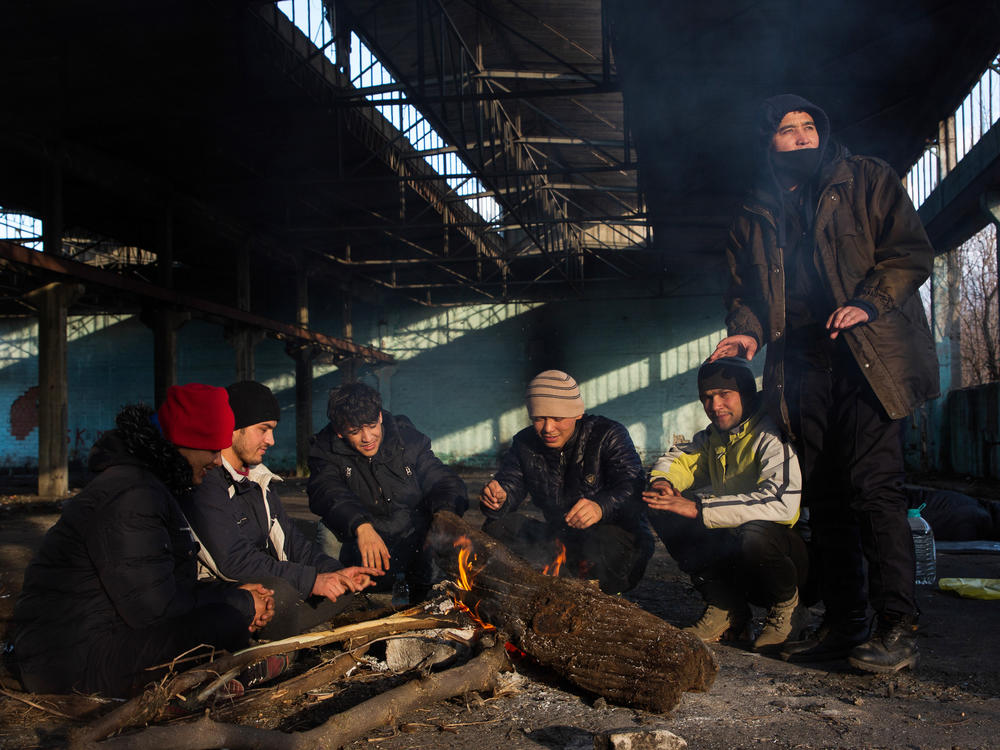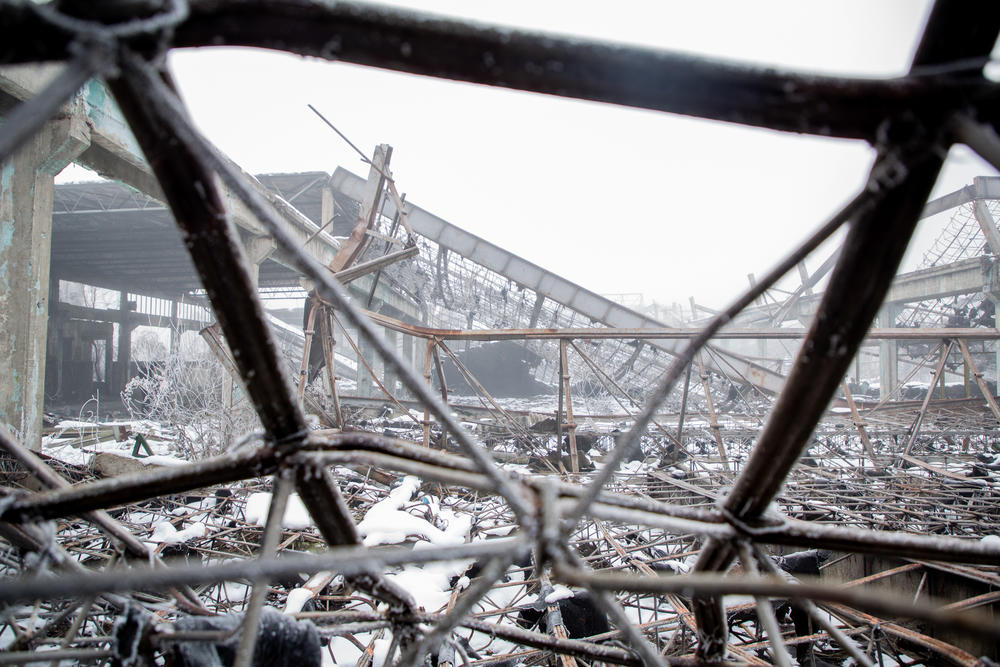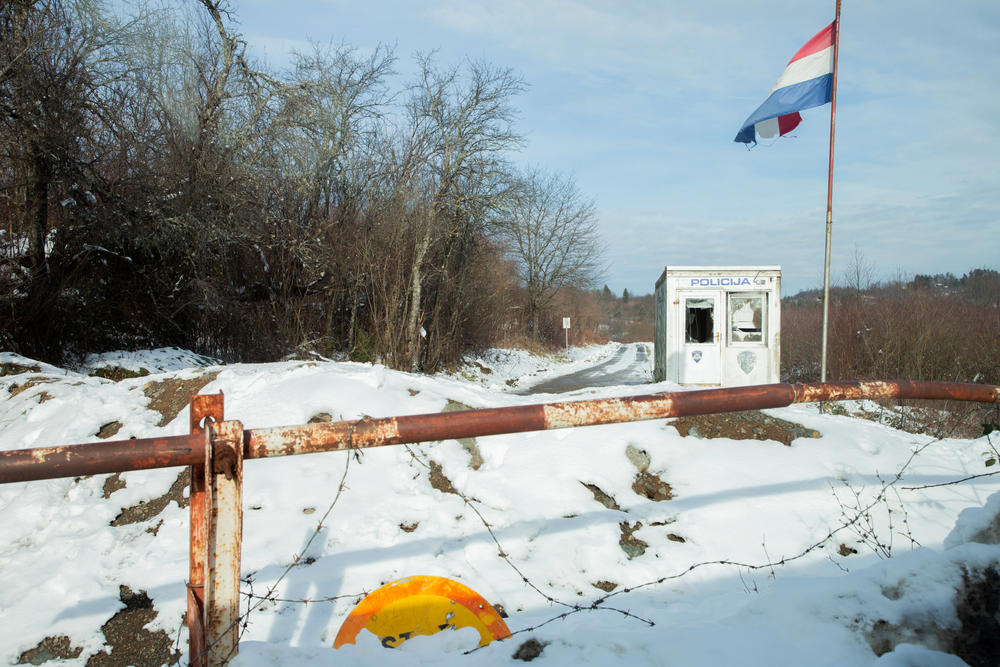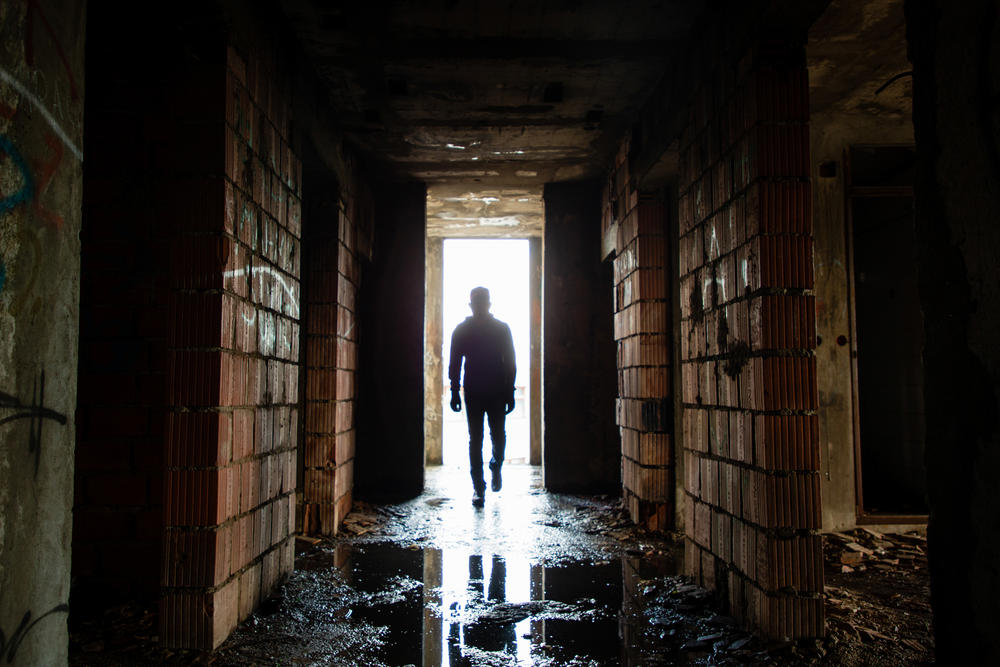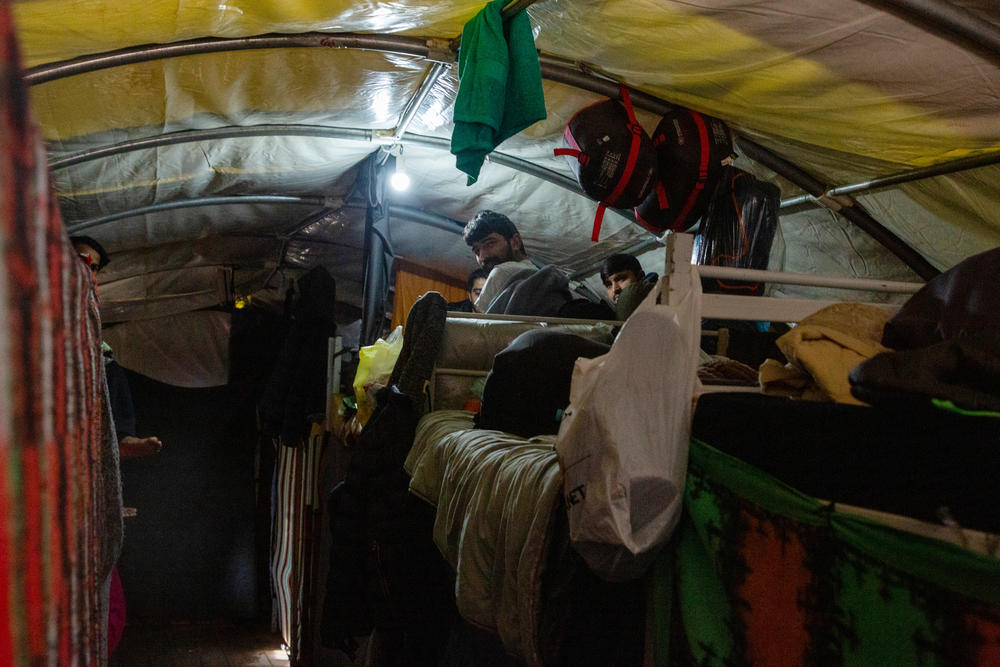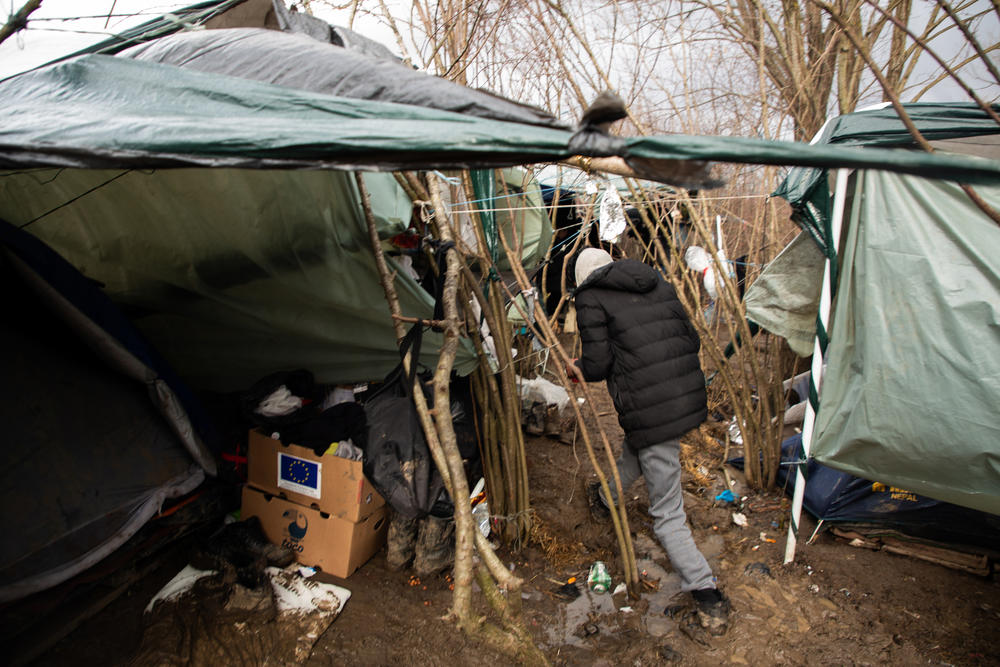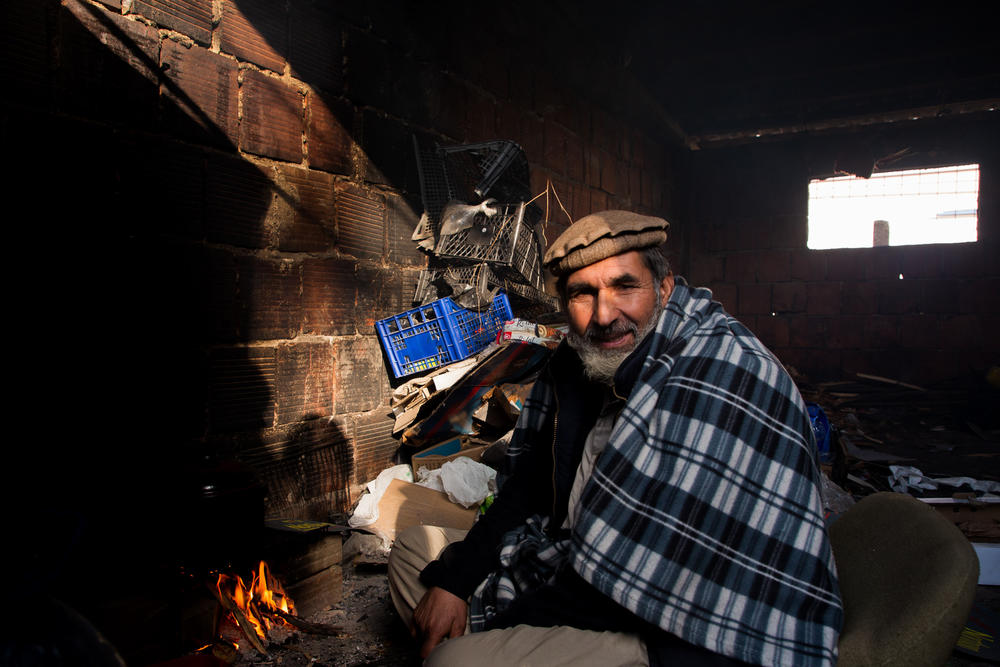Section Branding
Header Content
For Migrants In Bosnia, The 'Game' Is A Perilous Journey To A Better Life
Primary Content
BIHAC, Bosnia-Herzegovina — As the sun sets over the ruins of the former Krajina Metal factory, in the northwest part of this Balkan country, Morteza Mohammadi's face emerges from a pile of blankets and sleeping bags.
Slowly stretching and rubbing his hands together to keep warm, Mohammadi, 21, sits up and grabs his bag. A few feet away, his companions sit in silence around an improvised fire. The temperature will shortly plunge a few degrees below freezing on a recent winter night.
Mohammadi picks up his phone and plays a traditional song from Afghanistan's Hazarajat region. The notes of a dambura, a regional lute, waft through the vast, empty space.
He is sewing his backpack in preparation for clandestine border crossings. His plan is to cross into the European Union member states Croatia, Slovenia and eventually Italy — a dangerous journey migrants and refugees here refer to as "the game."
Mohammadi says the risks are worth it.
"We left because the Taliban and other militias are Afghanistan's cancer," Mohammadi says, his companions nodding in agreement.
"They are violent and carry out suicide attacks. In one moment you die, just like this," he says, snapping his fingers. "I want peace and a future. I finished high school. I want to reach Italy because I know there are many Afghans there. Maybe I could work in a restaurant."
Mohammadi plans to leave in a few hours, traveling on foot through the mountains at night to reach the Croatian border by morning.
"It is still very cold at night, which means less police on the border," he says. "I hope not to get beaten up by the Croatian police this time. It already happened; they steal and burn your belongings, take your shoes and break your bones."
This is his seventh attempt.
A crisis within a crisis
About 400 migrants, including minors as young as 13, currently live in the sprawling, defunct factory at the entrance of Bihac, around 9 miles from the Croatian border, also the entrance to the EU.
The property is a relic, destroyed during the war that raged in Bosnia between 1992 and 1995. No water, electricity or toilets are available now, so the migrants make do as best they can.
Bosnia-Herzegovina became the main hub for migrants hoping to reach wealthier European countries after authorities closed the previous migration route through Serbia and Hungary in 2016. Now it's the shortest possible way to access the EU.
But the bloc is failing to effectively address the humanitarian crisis unfolding on its doorstep. Meanwhile, Bosnia's poverty, complex political system, corruption, high unemployment — and its people's difficulty in burying the legacy of their past war — all stoke resentment against migrants, creating a crisis within a crisis.
Nearly 70,000 refugees and migrants from the Middle East, South Asia and Africa have passed through Bosnia-Herzegovina in the past three years, according to the International Organization for Migration. Today, some 6,000 live in five main camps run by the United Nations agency in coordination with local authorities scattered across the country, according to the IOM.
Laura Lungarotti, the organization's chief of mission in Bosnia-Herzegovina, says the situation is particularly complex in the area around Bihac. Last September, a migrant camp called Bira was closed downtown, following protests staged by locals, complaining it was the only case in Europe of a sprawling refugee camp located in the middle of a small town.
Then another settlement in the area called Lipa camp burned down in December, leaving refugees and migrants with nowhere to go.
"The remaining official temporary reception centers are overcrowded, and a couple thousand migrants currently live in the open or in abandoned buildings," Lungarotti says.
Those include makeshift shelters like the Krajina Metal factory and the Dom Penzionera building, a drafty, multistory structure on the bank of the Una River that now houses over 100 migrants, mostly from Afghanistan and Pakistan. The building was intended as a retirement home, but was left unfinished at the onset of Bosnia's war.
After the cold winter months, many migrants outside the official camps are suffering from respiratory problems and infections. Eight cases of the coronavirus were recently recorded inside one of the camps, the Borici Temporary Reception Center in Bihac, where tests are administered. Outside the camps, undocumented migrants don't have access to health care, making it impossible to understand how widespread COVID-19 is.
Most migrant families living outside the IOM-run camps have found shelter in abandoned houses in Bosanska Bojna, an area near the border with Croatia. They occupy abandoned or empty houses that belonged to Serbian refugees who moved on to Serbia, Germany or other European countries.
Police-led evictions happen routinely, but migrants and refugees usually return to their former squats and makeshift shelters within a day.
"Cruel, inhuman and degrading treatment"
Many migrants have reported increasingly violent pushback from Croatian security forces along the border during their crossing attempts. International agencies have documented cases of violence since last year.
"In May 2020, a number of shocking reports were recorded, where persons were exposed to practices that involved cruel, inhuman and degrading treatment, including spraypainting of crosses on persons' heads, severe beatings and deprivation of property," the Danish Refugee Council reported in October. "The absence of full, impartial and independent investigations — and the impunity of the perpetrators it leads to — can only result in further deterioration of the situation at the border."
The Croatian government has denied those allegations.
"We do not support any form of violence or intolerance from police officers, particularly towards persons who find themselves in such a vulnerable position and who are seeking international protection in the Republic of Croatia," the Interior Ministry wrote in a statement to NPR.
"However, in all of the cases so far in which information regarding police officers inflicting physical violence on migrants or illegally seizing their belongings was received and investigated, no evidence was found which would suggest the use of coercion on migrants," the statement read.
A young man from Pakistan attempting to cross through Croatia earlier this month was killed near the Bosnian border after stepping on a landmine left over from the 1990s Balkan wars. Others were injured in the explosion, according to local authorities.
Even those who make it as far as Italy have experienced chain pushbacks, eventually landing back in Bosnia after being moved through several Balkan countries. A civil court in Rome in January deemed the pushbacks of asylum-seekers and migrants on the Italian-Slovenian border illegal. After initial uncertainties on whether new pushbacks were still happening following this sentence, random expulsions seem to have recently come to a halt.
"Pushbacks from Italy to Slovenia were not carried out in the past few weeks," says Gianfranco Schiavone, an Italian legal expert and deputy chairman of the Association for Juridical Studies on Immigration. "Although we still need to thoroughly verify the overall situation, there seems to be a return, and I hope a definitive one, to a situation of legality concerning the rights of migrants and refugees to access Italy."
EU funds
Mohammed Arsal, a 29-year-old from Pakistan's Punjab province, says he started his journey in 2018, crossing into Iran, Turkey, Greece, Macedonia, Serbia, and eventually Bosnia. He's now one of some 800 people living in the new Lipa camp, which has been under reconstruction since a fire gutted it last December.
"I have been stopped and pushed back five times in Croatia and once in Slovenia," he says. "I have been beaten up during the pushbacks several times. Other people got their limbs broken. We don't receive any medical help here in the camp, unfortunately. We just get Panadol [acetaminophen] pills."
On a visit to the Lipa camp in late February, top EU migration official Ylva Johansson said the border beatings and pushbacks were "not acceptable."
"We are in very close contact with Croatian authorities on this issue and we are working together to set up a monitoring mechanism to make sure that these kinds of violent pushbacks do not take place. We cannot tolerate that," she told reporters in the camp.
Since early 2018, the EU has provided Bosnia-Herzegovina with 89 million euros (nearly $105 million) to meet the immediate needs of refugees and migrants, and to help the country strengthen its migration management capacities. But this money is mostly funneled through the IOM and doesn't go directly to Bosnian institutions, leading locals to question how the funds are really used.
"As of the end of December 2020, the EU adopted an additional 25 million euros [$30 million] to support Bosnia and Herzegovina in managing migration," Lungarotti says. "Part of this and previous funding also goes to the local and state authorities to be able to better face the response. Funds provided by the EU or other donors ... are coordinated with the Ministry of Security, the EU and other donors."
The agency regularly publishes on its website information on the implementation of EU-funded projects related to the emergency response to the migrant and refugee situation in Bosnia-Herzegovina.
But Bihac Mayor Suhret Fazlic tells NPR that his city budget has remained unchanged since the beginning of the migration crisis.
"We haven't received any euro from any level of authority in Bosnia, from the EU commission or the U.N. and other international organizations," he says. "What we received was only funding for some community projects related to street lighting."
"I will reach a better country, God willing"
Meanwhile, tensions over the presence of refugees and migrants are boiling over, especially in Bihac.
"How to share the burden of the migrant situation in the country is a question that we kept repeating since 2018," Fazlic says. "The problem is that migrants want to come here because this is the nearest way to reach the EU. But especially in winter, it is crucial that we share the number of migrants across the whole country. Sometimes in Bihac, we have more than 7,000 migrants against a population of 60,000 people."
The population of Bosnia's two autonomous regions is about 3.5 million. Banned from staying in the Serb-dominated Republika Srpska, refugees and migrants are only allowed in the federation shared by Croats and Muslim Bosniaks, stirring public anger even more.
Cases of violence between locals and migrants, and among migrants of different ethnic background, recently made headlines in local newspapers across the country and social media. Also, private groups on Facebook calling for tougher measures to tackle migration and saying those already living in the country, and especially in the area around Bihac should be kicked out.
On Sept. 30, local authorities emptied the Bira camp in downtown Bihac in response to local complaints about migrants. It could shelter up to 1,500 people and would be suitable for winter conditions if reopened, but locals have been staging daily protests in front of the camp in recent months, making sure migrants don't access the area.
One of the protesters, a former refugee during the Bosnia war himself, says he knows what it's like to be displaced.
"We were hosting migrants in our homes three years ago," he says. He did not want to be identified amid complaints that local citizens have been indiscriminately attacked and smeared by the press due to their protests. "We were also refugees during the war and our city was under siege for over a thousand days back then. We understand them, but the situation has now changed. They are just too many."
As the weather warms, thousands of refugees and migrants arriving from neighboring Serbia will try their luck and attempt "the game." Many will be pushed back and stuck in the same limbo as those staying in places like the Krajina Metal factory.
Mangal Saifullah, a 57-year-old from Afghanistan, prepares his lunch at the factory, boiling water on an improvised fire. He has been in Bosnia for a year and already tried to cross into the EU, without specifying how many times.
"I was a farmer back home and a fighter for 40 years," he says. "I fought during the Russian invasion throughout the 1980s and then the Taliban. I fought all my life in the mountains. There are problems with ISIS, al-Qaida and the Taliban back home and I need to help my family. I have nine children. I will reach a better country, God willing. My heart only says: Pray to God and have God in your heart. You cannot take the wrong path in this way."
Copyright 2021 NPR. To see more, visit https://www.npr.org.
